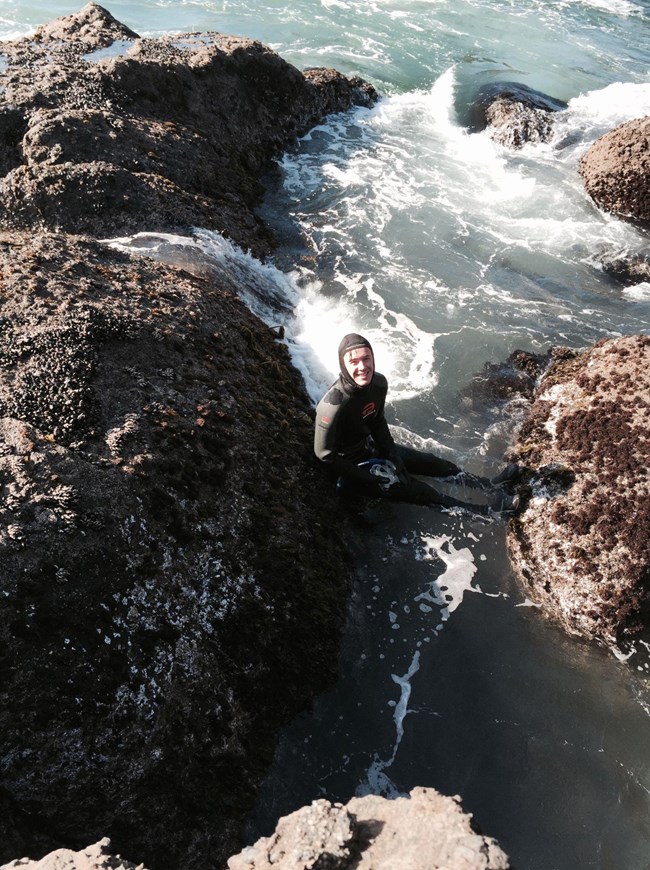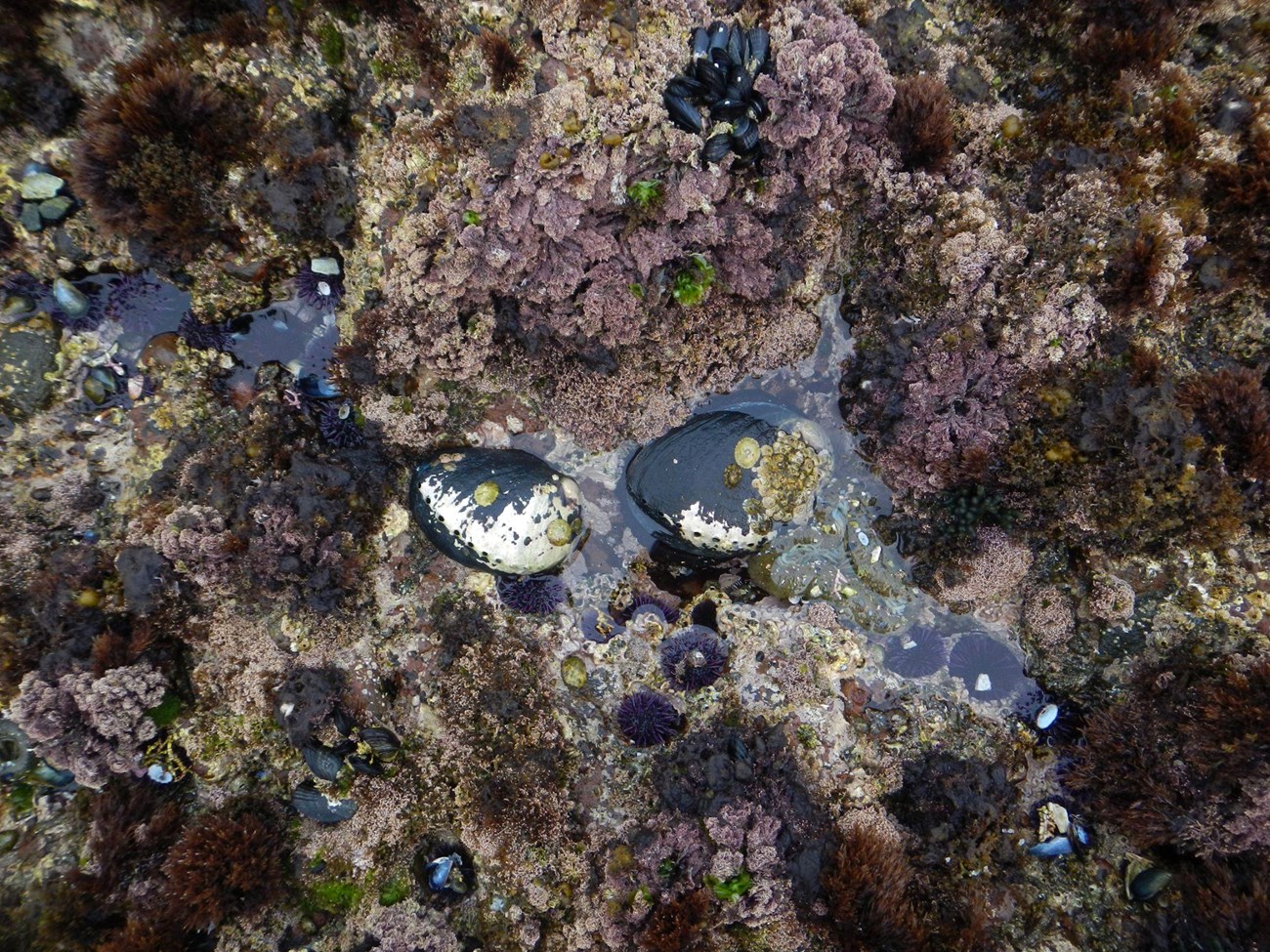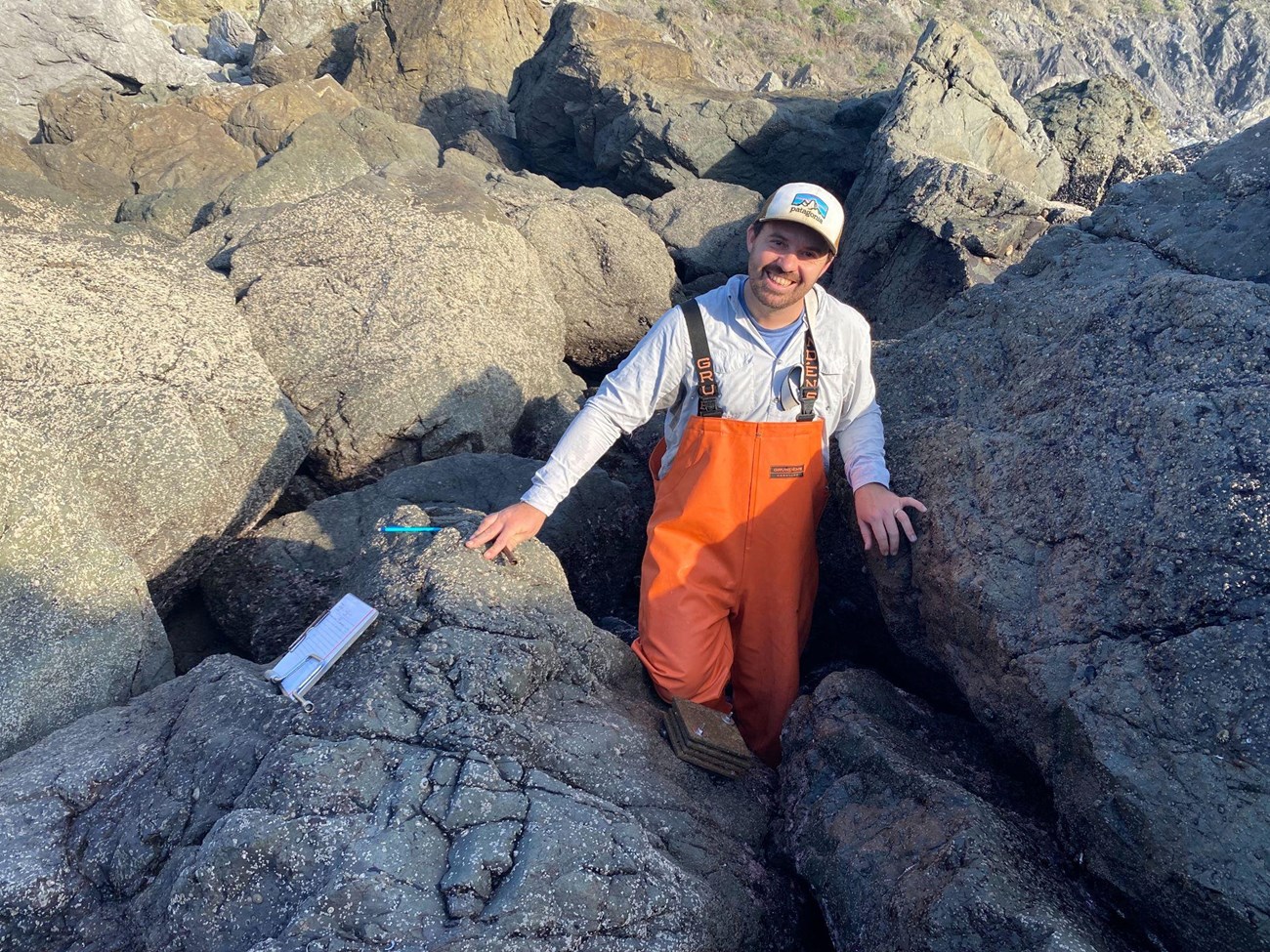Last updated: April 28, 2022
Article
“Why Black Abalone?”: The Duality of Black Abalone in California
One of the most resilient species of abalone in California is also one of the most endangered.
By Theodora Mautz, Point Reyes National Seashore Association / National Park ServiceBlack abalone are endangered marine snails that live in tidepools off the coasts of California and Baja California. Their history is intricately tied to human history in California. To learn more about the science and history behind black abalone, check out these two podcast episodes from The Natural Laboratory at Point Reyes National Seashore.

Theodora Mautz / PRNSA / NPS
When I told people that I was making a podcast on black abalone, I was met with one of two questions in response: 1) “What are abalone?” or 2) “Why black abalone?” If you find yourself asking the first question, like I did when I was first told what my assignment was, you can listen to those podcasts here and learn all about abalone ecology and history (with a focus on black abalone). If you are curious about the second question, you’re in the right place. I should note that I am not answering the “why” of black abalone to convince you of their importance or value: one of the main takeaways of the podcasts is that their “importance” lies in their very existence in the world, and in the roles they play in their communities and in ours. Rather, I hope to elucidate why black abalone represent an interesting case study in delicate balances: between marine and terrestrial, ancient and Anthropocene, and vulnerability and resiliency in those contexts.

Jace Ritchey
One of the most meaningful parts of this black abalone assignment was seeing how certain coastal California residents grew excited when I mentioned abalone. Some pointed to the abalone shells lining their fences, strung up in a time when abalone shells were as abundant as the creatures that inhabited them. Others showed me shimmering earrings that had been carefully carved out of the mother-of-pearl interiors of those shells, also acquired long ago. Best of all was when someone had a story to tell about abalone, because each story was filled with a sense of deep nostalgia, as if for lost kin. One person I spoke with shared how enjoyable it was to hunt for red abalone with her family. She remarked that although she may have touched a black abalone sight unseen, she has never hunted them nor seen anyone do so. Point Reyes National Seashore Park Ranger Jace Ritchey grew up hearing their parents tell stories of diving for abalone when they were more plentiful, and even went free diving for red abalone as a teenager a few years before it was banned. Notably, almost all of these stories and memorabilia were of the large and popular red abalone. I couldn’t find anyone who had personal experiences with black abalone, other than the researchers that are now working so hard to recover them.
At first, I was confused about why black abalone lacked the same popularity as red. As the only abalone that live predominantly in tidepools, the most shallow and accessible marine environment for humans, I would’ve expected black abalone to be the most familiar of their kind. Ann Vileisis’s beautifully-written book, Abalone: The Remarkable History and Uncertain Future of California’s Iconic Shellfish, provided some answers: black abalone are smaller and their meat is tougher than many other abalone species. Historically, many people preferred the tender meat and larger, more valuable iridescent shells of species like the red abalone. It wasn’t until red and other abalone species’ populations started dwindling in the 1970s that people turned to black abalone and began to overharvest them as well.
Even now, with its endangered status, black abalone are still often overlooked by the general public. White abalone have garnered a lot of attention in the past few weeks: The New York Times recently published an article about breakthroughs in white abalone recovery, led by Dr. Kristin Aquilino at the Bodega Marine Laboratory at University of California, Davis, through the use of ultrasound technology to aid in captive breeding programs. The abalone ultrasound research was conducted by Dr. Sara Boles, Dr. Jackson Gross, and colleagues, also out of the Bodega Marine Laboratory. And this is thrilling news for those in the abalone world—a victory for one abalone species is a victory for them all. Unfortunately, black abalone are the only California species that have yet to be spawned in captive breeding programs. Interestingly enough, Dr. Gross shared that the ultrasound technology research was initially funded to support black abalone recovery, and he is hopeful that one day it will. With all the attention that’s been paid to the white abalone, and the disproportionate share of collective nostalgia heaped onto red abalone, it seemed an opportune time to write this article to accompany the black abalone podcasts.
Earlier, I mentioned that black abalone are the only abalone species in California that predominantly live in the intertidal zone, where tidepools form. While the other abalone tend to prefer the relatively calmer environments of subtidal sea floor, the black abalone have been subjected to the violent merging of land and sea for millions of years. In that sense, black abalone are the bridges between our habitat and the habitats of all other abalone species: we can observe them at low tides when their ecosystem reveals itself to us. This area may be the most accessible marine environment for humans, but it is one of the most challenging and tempestuous environments for creatures to live in. As the famed environmentalist Rachel Carson wrote in her book, The Edge of the Sea, the intertidal zone is “the primeval meeting place of the elements of earth and water, a place of compromise and conflict and eternal change.” The black abalone that live here have to somehow withstand both blistering sunlight and smashing waves. They have to survive attacks from both land and sea predators. They must count on the advancing sea to bring them their food, and wait for the receding sea to carry away their sperm and eggs to fertilize in the water. Anything that can survive this hybrid landscape is nothing short of miraculous.

Maya George / UCSC
This ability to survive drastic environmental changes provides a model for resiliency in the face of climate change. As black abalone experts Susan Wang (Black Abalone Recovery Coordinator at the National Oceanic and Atmospheric Administration) and Pete Raimondi (Professor of Ecology and Evolutionary Biology at the University of California, Santa Cruz) told me, black abalone are far more resilient to climate-change related impacts like increasing temperatures and changes in pH and oxygen levels, which can have irreparable impacts on other marine life. This might even be one of the reasons black abalone are the only abalone species we have yet to spawn successfully in a lab: the combination of environmental triggers that induce other abalone species to spawn may be too simplistic for the black abalone.
Unfortunately, this resiliency hasn’t protected the black abalone from some more subtle impacts driven by climate change in the Anthropocene. In 1983, a record-breaking warm water climate pattern called El Niño carried a new bacterium into Southern California waters. This bacterium introduced a new disease in black abalone populations in Southern California called withering syndrome. Withering syndrome killed off 99% of black abalone at Channel Islands National Park, according to Marine Ecologist Steve Whitaker. Where park scientists had once found black abalone stacked on top of each other four or five deep just a few years earlier, they could no longer find even one. Researchers and policymakers have worked tirelessly to find innovative strategies and engaged in collaborative rescue efforts for the black abalone for the past thirty years.

Theodora Mautz / PRNSA / NPS
I don’t want to spoil all of the podcasts, but I will say that just a few years ago, the black abalone started rebounding exponentially in a few sites at the Channel Islands. Many of the black abalone experts said that they were incredibly heartened by this development, and hopeful for the future. It will require a lot more coordinated effort and innovative strategies to recover black abalone populations back to stable levels throughout Southern California, but it is always nice to hear when those working in conservation are optimistic about the future of an endangered species. The prevailing theory is that a viral phage has been consuming the bacteria that causes Withering Syndrome. But I wouldn’t be surprised if the nascent comeback of black abalone is also partly attributable to the tenacity and resiliency of the black abalone themselves, who are long accustomed to surviving adversity.
The road to full recovery will be long and challenging. Luckily, many passionate and talented people are working on abalone recovery, for several abalone species. In the case of black abalone, the general public may one day be able to bear witness to the success of conservation efforts. It is my (and many others’) hope that one day, California residents and visitors will be able to walk out to tidepools, notice the return of the striking blue-black shells of black abalone, and think not, “What are those?” but, “There they are again at last.”
To learn more about abalone:
- The Natural Laboratory at Point Reyes National Seashore podcast episodes on black abalone (National Park Service)
- Abalone: The Remarkable History and Uncertain Future of California’s Iconic Shellfish by Ann Vilesis
- “Holding Fast for Abalone, Our Elder Relatives,” by Jacquelyn Ross (Bay Nature)
- “Researchers See ‘Future of an Entire Species’ in Ultrasound Technique” by Wudan Yan (The New York Times)
- “Can the Long-Lost Abalone Make a Comeback in California?” by Rosanna Xia (Los Angeles Times)
- “Holding Fast, or Failing? There are dozens of confounding elements working against abalone recovery on the California coast” by Dominick Leskiw (Earth Island Journal)
- “Fires, mud, and abalone” by Kenan Chan (Oceanographic)
See more from the Bay Area Nature & Science Blog
Tags
- channel islands national park
- golden gate national recreation area
- point reyes national seashore
- sfan
- pcslc
- blog
- marine life
- invertebrates
- marine invertebrates
- mollusk
- mollusks
- gastropod
- gastropods
- abalone
- threatened and endangered species
- endangered species
- black abalone
- haliotis cracherodii
- rocky intertidal
- resilience
- first person perspective
- point reyes national seashore association
- science communication
- podcasts
